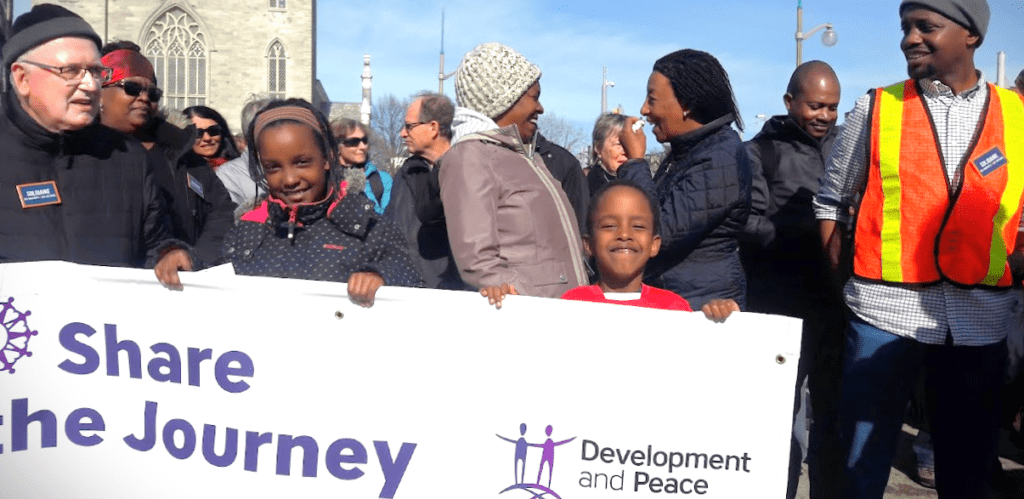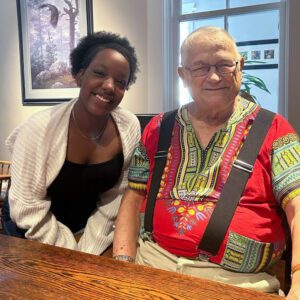By Reine Patricia, daughter of Richard Rudashama, Animator for Western Quebec and Eastern Ontario


Hello,
My name is Reine Patricia. I am 14 years old, and a student in Grade 9, in Gatineau, Que.
Since early childhood, I always saw my father go on trips for several weeks at a time, without knowing exactly where he was going. What mattered to me was that he brought me back lots of presents. However, as I grew older, I began to wonder about the reasons for his frequent departures and long absences. When I asked him, he simply replied that he was going to help people in the world who needed it most.
I wondered why he had to leave the country to help the most impoverished people. Weren’t there poor people in our own streets? Besides, we were not rich ourselves.
Over years of explanations, I came to understand that he often travelled abroad to organize communities, to meet their leaders, to raise awareness in the Global North about injustice and poverty, and to raise funds to support people in the Global South who were implementing alternative solutions.
More than just a job
What I still struggled to understand was his frequent refrain, “My child, it’s not a job. It’s a passion. One does a job, but one lives a passion.” At that time, Dad worked for the Coalition du Mouvement Nord-Sud en Flandre – 11.11.11, a Belgian international solidarity organization.
To slake my thirst for understanding, I kept pestering Dad with questions. Finally, he arranged for me to meet with members of Development and Peace ― Caritas Canada, which he and Mom had joined as volunteers as soon as we had arrived in Canada, and for which he now works as a regional animator.
Dad told me that Michel Lacroix and Andrée Turgeon were longtime members. He thought they might be able to give me a sense of that passion.
Here, I will share how they came to know Development and Peace ― Caritas Canada and why, despite the passage of time and challenges and constraints along the way, they remain committed to the organization.
A movement against inequities


Michel Lacroix’s story begins with an immersion trip to Mexico to learn Spanish. There, he saw people living in extreme poverty, with many starving to death in a small village. When he returned to Canada, he was outraged by the inequalities in the system, where some people wasted food while others starved. Development and Peace ― Caritas Canada had just been created at that time, and Lacroix decided to get involved with the organization.
Later, he joined the organization as an employee. Over his 21-year career with Development and Peace ― Caritas Canada, Lacroix contributed to numerous projects, especially in the Arab world. Along the way, he realized that although one can be aware of the injustices and problems in the world, one cannot really understand them without seeing them with one’s own eyes. That’s why Lacroix’s dream for the organization is to send more members to countries in the Global South, so that they can really grasp what is going on.
Now a retired priest, Lacroix writes books about his many travels and does fundraising for Development and Peace ― Caritas Canada, notable by lecturing on his travel experiences and discoveries.
A movement that educates


Andrée Turgeon, now retired, discovered Development and Peace ― Caritas Canada in 1990, at one of its liturgical training sessions. At that session, the animator Marcelle Sinclair, had spoken about the organization’s missions and values. From that moment on, Andrée fell in love with the movement. She began to get involved by welcoming guests from the Global South who came to tour Canada for educational and fundraising activities.
Through the course of her involvement with the organization, Turgeon kept being deeply moved by one question: Why help people in the Global South when there are poor people here? She recalls a Development and Peace ― Caritas Canada campaign in 1987, Qui nourrit qui ? (Who Feeds Whom?), helping her realize how our comforts are attributable to resources from the Global South. This is why Turgeon remains loyal to the movement: because it shapes and transforms individuals. The organization is not content to just provide material aid; it is also distinguished by its profound educational aspect.
Turgeon would like for on Development and Peace ― Caritas Canada to develop more creative ways of raising awareness, especially using less text and more visual communication. She currently serves on the organization’s Saint-Jérôme–Mont-Laurier diocesan council. Her fundraising activities include making and selling pizzelles (Italian waffles).
Your movement, your story
To conclude, I would like to invite secondary and high school students reading this article to share their stories. Have you heard of Development and Peace ― Caritas Canada? Do you know people who are members of the movement?
If your answer is “yes,” do you want to ask what motivates them and write a short article like this one?
If your answer is “no,” do you want to do a little research about this organization and write a short article on what you find inspiring?
Send your text to youth programs officer Emily Bowman-Lukasik at Emily.Lukasik@devp.org.
Thank you, and I look forward to reading your story!

